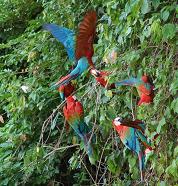Blue Hill Escape

Parrot News
26 September 2009
How has the recession impacted ecotourism in Peru? The view from the Tambopata
Alan Lee
The collapse of Lehman brothers and the stock market crash of September/October 2008 will be remembered by anyone with investments, pensions or simply access to any news channel. US and eurozone recessions have meant unemployment levels not seen for the last ten years or more for many countries. So how has this all impacted ecotourism in Peru?
The Tambopata region of southeastern Peru has experienced dramatic year on year growth in tourism for the last ten years, as the area is now considered a safe and exciting destination. In 2005 tourism to Tambopata was worth $14m (5% of Peru’s GDP). Rainforest access is easy due to a large airport and many professional tour operators. The number of tourism lodges has grown from 2 in 1974 to over 30 in 2008. These range from ‘home-stay’ tourism activities to large luxurious lodges. Most tourism is linked to package holidays, where the rainforest is an add-on to the standard Peruvian tours that include Macchu Picchu, Nazca Lines and Lake Titicaca.
Some of the biggest operators in Tambopata are Inkaterra, Inkanatura (who own two lodges in the region) and Rainforest Expeditions (who own or co-own three lodges). When asked by Kurt Holle, managing director of Rainforest Expeditions, to guess what the consequences of the financial crisis would mean for tourism, I estimated in October 2008 (based on share-price falls etc end 2008) that we would see a 10% fall in tourism from Europe, possibly as high as 15% from Great Britain. Although I did not extend this guess to USA, I imagined that it would be the same or more since it was the seat of the financial crisis. Mr Holle was relieved to hear this as the three Rainforest Expeditions lodges are overbooked by up to 20% through the high season.
During a visit in July 2009 (June – August are traditional high seasons associated with northern hemisphere holidays and Peru’s independence) I was able to gauge better how my forecast had been. As expected, Rainforest Expeditions was doing well. This may have been a result of people making the most of holidays booked before the crisis, but also has to do with the amount of money and effort invested in marketing and market research by this large company.
However, things appeared to be different with the smaller enterprises. Conversations with lodge manager Dustin Rojas of Explorer’s Inn (the oldest lodge on the Tambopata) revealed deep concerns in the falling number of visitors. Fear was expressed that if things were worse in 2010, then the future of the lodge was uncertain. At Inotawa, a newer and smaller family establishment, numbers were notably down. On a visit there lasting several days, for most of the time my group of Earthwatch volunteers were the only guests – a big problem for Inotawa considering this was the on-set of the high season. Anecdotal evidence suggested that other small players, such as Caiman Lodge – catering mostly to French tourists – had also been hardest hit. Chris Kirkby, who recently submitted his Phd on the impact of the Interoceanic highway and its consequences for the tourism industry, said that tourism across the board was down 30%.
The Tambopata Macaw Project and its conservation research has also been negatively impacted. Much of the project income (most of which goes to paying local field assistants) is generated from volunteer based tourism such as Earthwatch. Traditionally, four teams are fielded each year. Of the three field teams scheduled from November 2008 to January 2009, only two ran; although this had been the case the previous season too. However, this season also coincides with a low recruitment period for Earthwatch.
In an effort to accommodate this, the project had successfully trialled a summer (June) excursion during 2008. Early 2009 and the June expedition looked promising, with two recruits already signed up. The project also agreed to put on an extra expedition to accommodate a school group. This was cancelled a few months later as the group could not come up with the deposit and the original group had two signees up till the last moment. Although this would normally have been cancelled, investments had already been made for two groups and so alternate plans were made to accommodate this tiny group. Unfortunately things don’t look much better for the upcoming field season.
In line with other recession trends, this downturn was to be expected
as people tighten their belts and look for ways to save. Although some environmentalists
have been optimistic about the downturn as it has resulted in lower carbon dioxide
emissions, these are short term views if in the long term people currently employed
in the ecotourism industry have to go back to mining, woodcutting and small scale
agriculture. With most large economies now emerging from recession, we hope that
2010 will be better, but it will probably be a few years yet till the same numbers
of tourists ride the rivers of the Tambopata to enjoy the world’s most spectacular parrot
and macaw community.
Older posts:
Clever mom! Green rumped parrotlets feeder smaller chicks preferentially
Nutritional content of the diet of wild Ara macao chicks (translation)
Spatial distribution and physical characteristics of clay licks in Madre de Dios, Peru
10 easy things to do to save the rainforest
Vocal matching by Orange-fronted conures (Aratinga canicularis)
Generalists, specialists and opportunists: niche metrics of Poicephalus parrots in southern Africa
Spring in Scotland with Hen Harriers
Why volunteer on the Tambopata Macaw Project
Green-wing macaws: A day in the life of a riverside claylick
Wild parrots and their feeding habits in the Peruvian rainforest